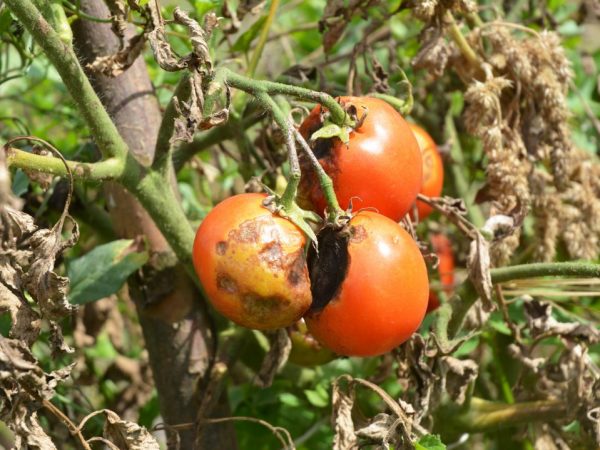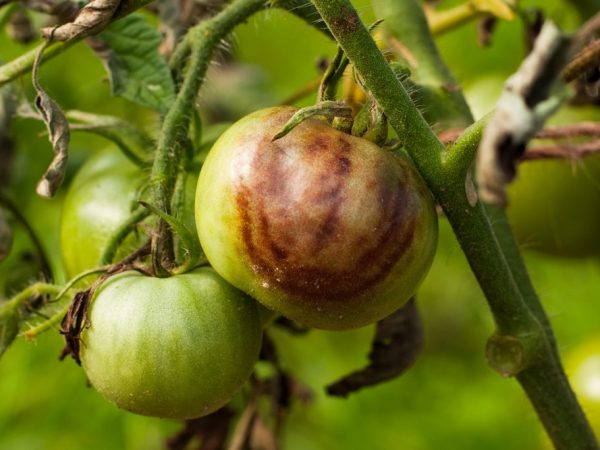Struggling with a tomato column
Stolbur is a common and dangerous disease of nightshade crops. Infection with this infection leads to the loss of a large part of the crop, therefore it is important to identify the Tomato Pillar at an early stage and begin to control it.

Struggling with a tomato column
Why is the stolbur dangerous?
The causative agents of Tomato Stolbur are mycoplasma and nightshade virus, which are phytoplasmic unicellular organisms. Revealed 2 types of reaction of the culture to the disease:
- speckled and striped spots are formed on the fruits;
- the color of the leaves changes to antacional.
Many pathogenic bacteria disrupt life processes in plant cells. Chloroticity, small leaves, terry, bushiness, vascular occlusion and deformation of inflorescences develop.
In tomato fruits affected by stolbur, the content of dry matter decreases.
Signs of infection
The color change of the stems begins from the tops, then the infection spreads to young shoots and lower leaves of plants.
- The stems of infected nightshade crops become pinkish due to the high content of anthocyanin pigments in the cells.
- The leaves of the affected plants shrink, curling upward, and take the shape of a boat.
- Internal tissues are saturated with starch, roots and stems turn brown, become covered with small cracks and become brittle.
- Affected flowers are deformed, sepals are separated or accrete, take the shape of bells.
- The internal organs of the peduncles are modified. The stamens and pistils stop developing, the petals become greenish or discolored.
- Infected flowers do not bear fruit, but if the ovary is still formed, the tomatoes grow small, lignified, tasteless and unsuitable for food. Their section shows white vascular tissue in the form of bundles.
Tatiana Orlova (Candidate of Agricultural Sciences):
Tomatoes affected by stolbur become practically inedible because in fruits carbohydrates in the form of sugars are converted into other carbohydrates - in the form of cellulose. These are the same white streaks.
Distribution methods

The cause of the disease is an insect
Stolbur, or phytoplasmosis, is a natural focal infection with a resistant natural pathogen. The main vectors of the disease are sucking insects, in particular Mlakosevich's leafhopper, green leafhopper and aphrodes clover, as well as aphids, moths, whiteflies.
In winter, the virus remains viable in the roots of perennial weeds, for example, plantain, field bindweed, milkweed, elderberry, St. John's wort. Larvae of cicadas also hibernate there. Feeding on the sap of infected plants, they themselves become infected. Adults retain the ability to carry the pathogen for 2.5 months. The peak in the number of vectors occurs in mid-July, therefore, the peak of the disease is at the end of August. The incubation period lasts a month.
In dry and hot weather, disease vectors multiply intensively. Cicadas avoid areas with woody vegetation, preferring to settle in virgin lands.The higher the terrain is above sea level, the lower the population density of cicadas.
The infection can enter the ground with contaminated seeds or seedlings. Also, the carrier of the virus can be non-disinfected hands, tools, clothes.
Stolbur prevention
There are no measures to combat phytoplasmosis. An infected plant does not respond to treatment, it must be destroyed in order to protect healthy bushes.
It is recommended to prevent stolbur infestation of plants. For this, a number of actions are performed:
- Disinfection of seeds. They are kept in water heated to 50 ° C, or in a 1% manganese solution for 20 minutes.
- Isolate nightshades from other vegetable crops.
- Mulching the soil with straw.
- Proper fertilization during the growing season.
- Regular weeding and weed control.
- Spraying with insecticidal preparations such as "Karbofot", "Iskra", "Actellik" and others.
Tatiana Orlova (Candidate of Agricultural Sciences):
Since insects are carriers of stolbur (and other viral diseases of tomato), the fight is against them. There is another interesting method. All insects find food by smell. You can "mask" these food items with a different smell. For example, tomato planting is treated with the following composition: 1 glass of milk (better than natural village milk, not boiled) and 5-6 drops of iodine are added to 1 liter of water. After processing, there is a pleasant smell of creamy ice cream over the tomato plantings. In addition, fresh milk contains arachidonic acid, which increases the resistance of plants to adverse factors. Tomato processing with this composition is carried out once a week during the active appearance of insect pests (3-4 times) per season.
Conclusion
Measures to combat tomato stolbur have not yet been developed. To prevent the disease, it is necessary to carry out preventive procedures and provide correct, timely care.



